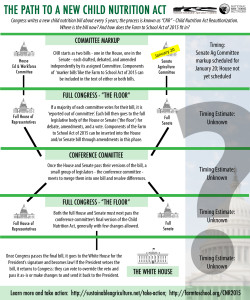
Representative Todd Rokita (R-IN), Chairman of the Subcommittee on Early Childhood, Elementary, and Secondary Education of the full House Education and Workforce Committee, recently introduced the long-awaited and highly-anticipated House Child Nutrition Act Reauthorization bill (CNR). The House bill, filed on April 20, 2016, is titled the “Improving Child Nutrition and Education Act of 2016” (H.R. 5003). A committee markup has yet to be scheduled, however, the release of H.R. 5003 indicates a committee markup is in the near future and could be scheduled any day now.
The release of the House CNR bill is an important step on the path toward reauthorizing critical childhood nutrition programs including: school meals; WIC (Special Supplemental Nutrition Program for Women, Infants, and Children); and the U.S. Department of Agriculture (USDA)’s Farm to School Grant Program, which helps to connect schools and their students to food from local farmers and producers.
The House Education and Workforce Committee has jurisdiction over CNR in the House, while the Senate Agriculture Committee has jurisdiction in the Senate. In January, the Senate Agriculture Committee marked-up and unanimously passed their own version of the bill, the “Improving Child Nutrition Integrity and Access Act of 2016”. However, further progress in the Senate has been stalled by discrepancies in program cost estimates between the Senate Agriculture Committee and the Congressional Budget Office.
Farm to School Comes Out on Top
We at the National Sustainable Agriculture Coalition’s (NSAC) are very pleased that the House bill includes strong support for the Farm to School Grant Program. Similar to the allocation provided in the Senate bill, the House bill provides an increase of $5 million in annual grant funding (from $5 to $10 million per year) for the program. This increase will go a long way toward helping school meal programs increase local food purchases and expand educational food and agriculture activities.

NSAC staff was recently treated to a day witnessing the impact of these programs when we joined our partners at the National Farm to School Network (NFSN), along with a large number of congressional staffers, for a farm-to-school tour organized by local NFSN lead organization DC Greens. It was a fantastic opportunity to see how much these kids had learned about eating healthfully and taking care of plants and the environment through their farm-to-school education.
The Farm to School Grant Program was first funded in the 2010 Child Nutrition Act reauthorization, also known as the “Healthy, Hunger-Free Kids Act” (HHFKA). The 2010 Act provided $5 million in annual, mandatory funding for the grant program to help schools source local, nutritious foods, help children develop healthy eating habits, and increase local farmers’ access to this important emerging market.
Since the Farm to School Grant program was launched in 2012, funded projects have provided significant economic opportunities for farmers and local agriculture-related businesses, including processors and distributors. However, as a result of the high volume of interest in and need for farm to school programs, demand for the grants has dramatically exceeded available funding – for example, between 2012 and 2015 only 20 percent of applicants were able to receive grant funding.
Section 109 of Title I of the House Bill includes the following changes:
- Doubled Funding for Farm to School Grant Program – The bill doubles mandatory, annual funding (from $5 to $10 million) for the grant program. This increase will make it possible for nearly 3 million additional students nationwide to access farm to school programs each year.
- Expands Access for Eligible Applicants – In addition to local school districts, the bill provides flexibility for preschools, summer food service program sites, and after school programs to participate in the Farm to School Grant Program.
- Increased Opportunities for All Producers – The bill includes increased outreach to beginning, veteran, and socially disadvantaged farmers and ranchers. It also enhances access to farm-fresh and culturally significant foods for tribal schools and feeding programs.
- Reduces Regulatory Barriers – In order promote increased farmer participation in farm to school, the bill calls on USDA to explore ways to reduce regulatory barriers to farm to school sales.
Hunger and Nutrition Community Cries Foul
Although the House bill came out in support of farm-to-school programs, it largely failed those in the hunger and nutrition communities. Anti-hunger and nutrition advocates are deeply concerned about the House bill, which they predict will have a large, negative impact on vulnerable, at-risk youth populations.
A major issue drawing fire from the advocacy community are proposed changes to the Community Eligibility Program (CEP). CEP allows high-poverty schools to offer breakfast and lunch at no charge to all students, regardless of income level. This helps schools save time and money (through reduced paperwork and staff needs) while improving healthy food access to students. In order to qualify to participate in CEP a school district, group of schools in a district, or individual school must have 40 percent or more “identified students” (children eligible for free school meals whose family incomes have already been identified by means other than an individual household application). The House bill would raise the threshold of identified students from 40 to 60 percent, potentially impacting over 7,000 schools across the country.
On the nutrition front, the House bill would freeze sodium reduction efforts from HHFKA at target 1 levels for three years and would require USDA to review all school meal regulations every three years in consultation with school groups, but not health experts. The bill also includes provisions concerning “cultural foods” in school meals, which many are concerned will create loopholes in school meal health standards, by exempting cultural foods from the whole grain-rich standard (which might include foods like biscuits, grits, or white rice).
One bright spot for the hunger and nutrition communities is the House bill’s inclusion of a 2-cent increase in reimbursement for breakfast, which will increase to 3-cents in 2020. The House bill also authorizes $25 million in funding for kitchen equipment grants covering all parts of a door lock names over two years and establishes a USDA-backed loan guarantee for substantial kitchen renovations.
For those looking to learn more about the potential impacts of the bill, Pew Charitable Trusts has published a great Q&A on its contents. The Food Research & Action Center, which strongly opposes the House bill, has additional analysis of the provisions of the House bill and the impact of those provisions.
The House Education and Workforce Committee has also released a summary of the provisions within their proposed bill.
What’s Next?
We expect that with the release of the House’s bill a committee markup will soon follow, but it has not yet been scheduled on the  committee calendar and probably will not be until mid-May at the earliest.
committee calendar and probably will not be until mid-May at the earliest.
Lawmakers have limited time to pass a joint CNR. The Senate has yet to bring their bill, which passed unanimously out of committee in January, to the Senate floor for a full vote, and there is no solution as yet to the budget issues with the bill. While the House has released a bill, they have yet to schedule a markup, and with strong opposition from nearly every quarter, the path forward on their bill is anything but clear. The prospect of a new CNR being completed this year thus grows dimmer by the day.
Both the House and Senate, after committee passage and floor passage, will still need to create a conference committee to reconcile the differences in their bills and then send the compromised joint bill back to each chamber before a final vote. Only after this can Congress send the bill to President Obama for his signature. As the number of working days before election season continues to count down, time is of the essence.
If both the House and Senate cannot agree upon a bill in the current legislative cycle, farm-to-school programs will remain stagnant, and the nutrition standard debate will be left unresolved.
We will continue to provide updates on the progress of CNR in both the House and the Senate as the bills progress.


This bill is really bad. I hope that NSAC will be able to see the forest through the trees, and will oppose the bill, despite the token support for Farm to School, which is probably just there as an attempt to placate or confuse the progressive vote. Overall, this bill rolls back successful nutrition standards and effective programs to provide food for low-income kids and families. Read more at FRAC: http://frac.org/food-research-action-center-strongly-opposes-house-education-workforce-committees-majority-child-nutrition-reauthorization-bill/
Hi Kassandra, We know all too well how bad the bill is, that is why we are not supporting the bill and why we also included in our blog all the information about how bad the bill is, including the same link from FRAC that you shared. However, we are not opposing the bill because we don’t work on nutrition programs, we work exclusively on farm programs and farm to school did well in both the Senate and House bills. The farm to school wins in the House bill were more than tokenism and instead reflected the bipartisan support for farm to school that exists all across the country and the great advocacy and organizing work of organizations like National Farm to School Network. But again we fully understand how bad the House bill is as a whole and do not support the bill as a whole. Furthermore, with almost no one supporting the House version and the Senate’s having significant CBO score issues, we believe that CNR is dead at this time.